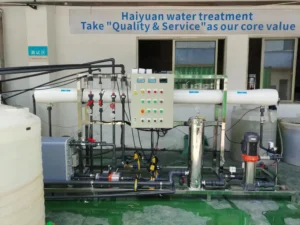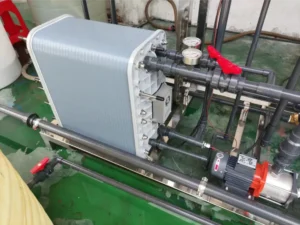EDI Water Treatment Reverse Osmosis Water treatment 3TPH
What is EDI water treatment and RO system?
– EDI water treatment:
edi water treatment produce high-purity water by using electricity and ion-exchange materials to remove dissolved ions.
Unlike traditional methods, EDI operates continuously without chemicals, offering an efficient and eco-friendly solution.
This process is chemical-free and continuous, offering a reliable and cost-effective alternative to traditional mixed bed ion exchange systems.
– RO system:
Reverse Osmosis (RO) systems utilize pressure to force water through a semipermeable membrane to remove dissolved salts, contaminants, and impurities, thereby purifying the water.
The system typically includes pretreatment filters, a high-pressure pump, and an RO membrane, and may incorporate post-treatment steps to further enhance water quality.


——————————————————————————————————————————————————
Real Case Basic Information:
Location: Pakistan
Source Water: Tap water (municipal supply)
Application: Electroplating process bath water
Production Capacity: 3 metric tons per hour (3 T/hr)
Key Parameter: Treated water TDS (Total Dissolved Solids) ≤ 1 ppm (ideally 0-1 ppm range)
| HY-EDI+RO-3T/hr | |||
| Flow rate | 3T/hr | Recovery rate | 60% |
| Applicable power | 220V/50hz 3 phase | Rated power | 6.05KW |
| Feedwater TDS | 800ppm | freshwater TDS | 0-1ppm |
| Working pressure | 10.7 bar | operating temperature | 5-45℃ |
| Feedwater residual chlorine | <0.1ppm | Feedwater SDI | <5 |
| RO membrane housing | 8040*3 core,1pieces | RO membrane | 3pieces |
| Installation dimensions: | L9×W1.5×H2.1(m) | Feedwater turbidity | <1NTU |

EDI water treatment process flow:
Raw Water Tank → Booster Pump → Multi-Media Filter → Activated Carbon Filter → Softening Filter → Precision Filter → High-Pressure Pump → RO (Reverse Osmosis) → Intermediate Tank → EDI Booster Pump → EDI (Electrodeionization) → Product Water Tank
| Step | Function |
| Pretreatment (Multi-Media Filtration, Activated Carbon Adsorption, Softening) |
Removes large particles, residual chlorine, organic matter, and hardness ions |
| Primary RO System | Removes most dissolved solids through reverse osmosis membrane, reducing TDS |
| Intermediate Tank | Stores RO product water to provide a stable water source for the EDI system |
| EDI System | Further removes ions using electric field and ion exchange resin to achieve ultra-pure water standards |
The role of edi water treatment:
EDI technology uses electricity and special resins to remove tiny charged particles (like salt) from water. This lowers the water’s conductivity to 0.055-0.2 μS/cm (which means it resists electricity very well, 15-18 MΩ·cm) and makes super-clean water.
EDI water system has several advantages:
1.No chemicals needed: No need for acid or base cleaning, making it safer and reducing waste.
2.Stable water quality: Produces high-purity water with minimal fluctuation in quality.
3.Smart and convenient: Supports automatic adjustment and remote monitoring, making management easier.
2.Stable water quality: Produces high-purity water with minimal fluctuation in quality.
3.Smart and convenient: Supports automatic adjustment and remote monitoring, making management easier.
—————————————————————————————————————————————————
To find the most appropriate for your use, please advise the following information:
-Product water flow rate ( m3/hr, m3/day, Liter/hr,GPM,GPD etc.)
-Product water purpose(drinking, irrigation, industry process or others)
-Feed Water TDS (Total dissolved solids). Is it from Borehole/salt/brackish/lake water
-Power (/380V/440V/460V, 50 or 60 Hz) 3 phase.
-It is necessary to make water analysis report for borehole water,lake water, seawater.
-If soure water is tap water no need water analysis report.
Quickly discuss and reply you. My whatsapp +86 18825874379, Email: haiyuan@swroplant.com
Or click here to get more info about productions.
